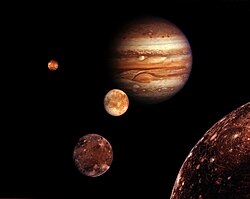 2002 UX25 and satellite, as seen by Hubble | |
| Discovery [1] | |
|---|---|
| Discovered by | Spacewatch (291) |
| Discovery site | Kitt Peak National Obs. |
| Discovery date | 30 October 2002 |
| Designations | |
| (55637) 2002 UX25 | |
| Cubewano (MPC) [2] Extended (DES) [3] | |
| Orbital characteristics [1] | |
| Epoch 5 May 2025 (JD 2460800.5) | |
| Uncertainty parameter 0 | |
| Observation arc | 33.35 yr (12,182 days) |
| Earliest precovery date | 12 October 1991 |
| Aphelion | 49.291 AU |
| Perihelion | 36.716 AU |
| 43.003 AU | |
| Eccentricity | 0.1462 |
| 282.01 yr (103,005 days) | |
Average orbital speed | 4.54 km/s |
| 309.49° | |
| 0° 0m 12.24s / day | |
| Inclination | 19.400° |
| 204.57° | |
| ≈ 5 September 2066 [4] ±3 days | |
| 275.27° | |
| Known satellites | 1 (ø: 190–260 km) [5] [6] |
| Physical characteristics | |
| 665±29 km [7] 659±38 km [8] | |
| Mass | (1.25±0.03)×1020 kg [6] |
Mean density | 0.82±0.11 g/cm3 (assuming equal densities for primary and satellite) [6] 0.80±0.13 g/cm3 [8] |
Equatorial surface gravity | 0.075 m/s2 |
Equatorial escape velocity | 0.227 km/s |
| 14.382±0.001 h [9] | |
| 0.107+0.005 −0.008 [7] 0.1±0.01 [8] | |
| Temperature | ≈ 43 K |
| B–V=1.007±0.043 [10] V−R=0.540±0.030 [10] V−I=1.046±0.034 [10] | |
| 19.8 [11] | |
| 3.87±0.02, [9] 4.0 [1] | |
(55637) 2002 UX25 (provisional designation 2002 UX25) is a trans-Neptunian object that orbits the Sun in the Kuiper belt beyond Neptune. It briefly garnered scientific attention when it was found to have an unexpectedly low density of about 0.82 g/cm3. [12] It was discovered on 30 October 2002, by the Spacewatch program; [13] as of June 2025, the object has yet to be named.
Contents
- Numbering and naming
- Classification
- Physical characteristics
- Composition
- Satellite
- See also
- References
- External links
2002 UX25 has an absolute magnitude of about 4.0, [1] and Spitzer Space Telescope results estimate it to be about 660 km in diameter, [8] making it one of the largest known unnamed objects in the Solar System. The low density of this and many other mid-sized TNOs implies that they have never compressed into fully solid bodies, let alone differentiated or collapsed into hydrostatic equilibrium, and so are highly unlikely to be dwarf planets. [14]




